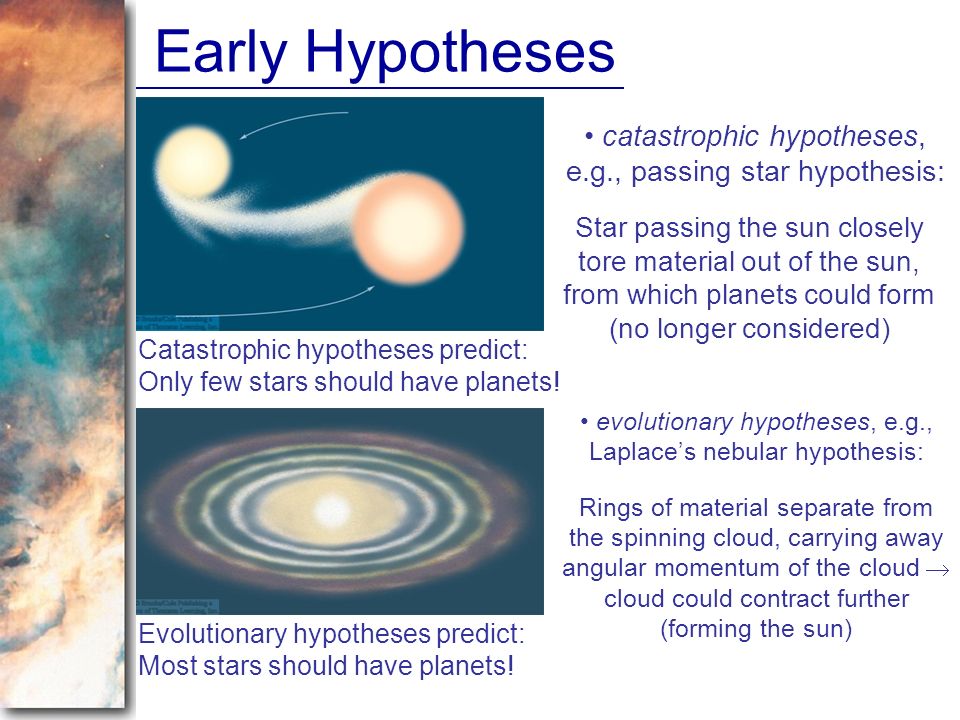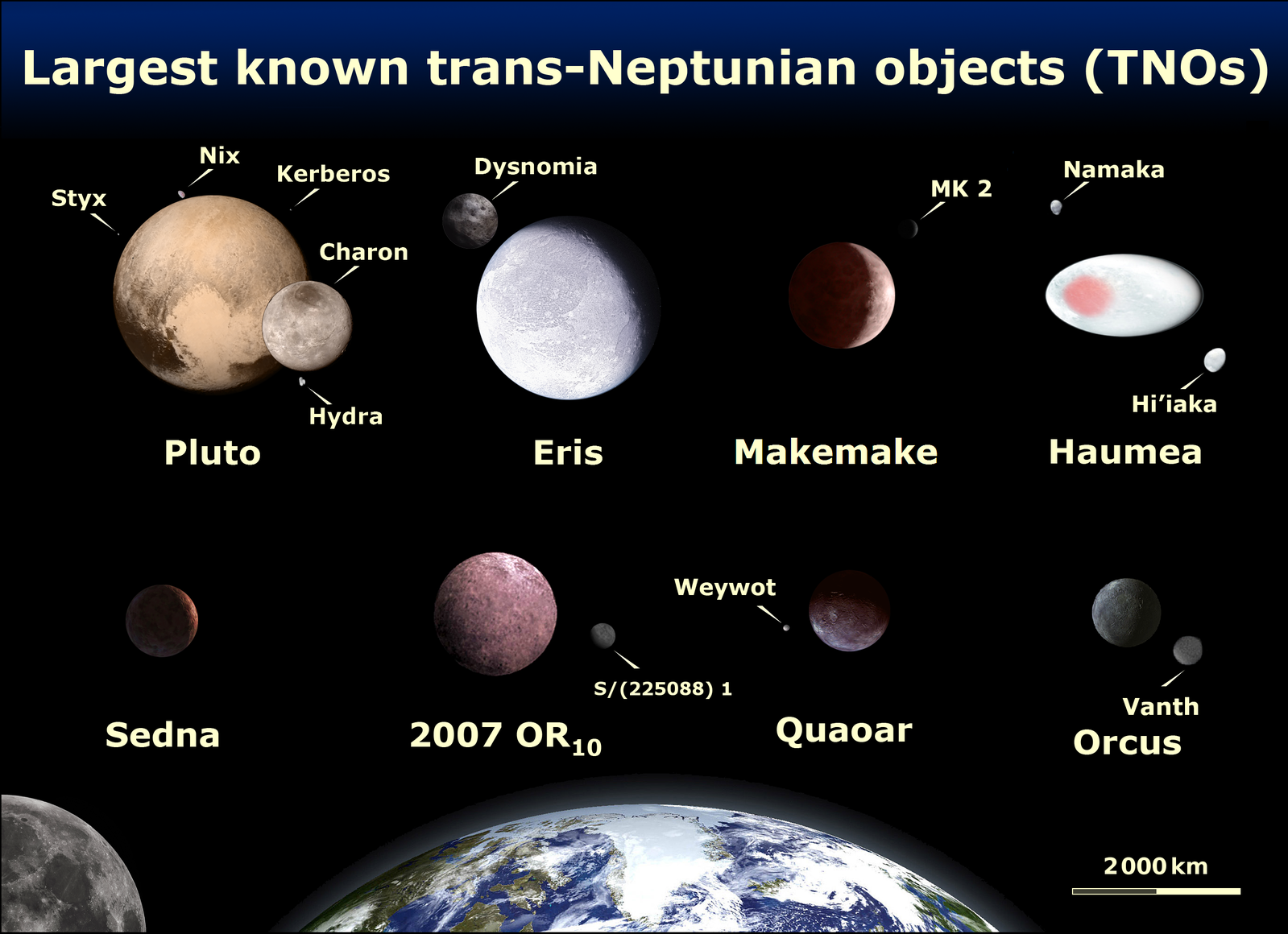Different Hypotheses Explaining the Origin of the Solar System
According to the BBT before the universe or anything and everything existed all matter and energy were condensed into high-temperature and high-density states. The gas that formed the Solar System was slightly more massive than the Sun itself.

The Origin Of The Solar System I The Great Chain Of Origins A Early Hypotheses B A Review Of The Origin Of Matter C The Solar Nebula Hypothesis D Ppt Download
Conservation of angular momentumrequires that a rotating disk form.

. Suddenly rapid expansion took place resulting in an explosion hence the name Big Bang. When it comes to the formation of our Solar System the most widely accepted view is known as the Nebular Hypothesis. Taking all these issues into account science has suggested five key theories considered to be reasonable in that they explain many but not all of the phenomena exhibited by the Solar System.
In this theory thewhole Solar System starts as a large cloud of gas that contractsunder self-gravity. Find out more below. The Earth the planet we live on is part of the Solar System.
SEVEN MORE FLAWS IN THE SOLAR SYSTEM THEORIESThere are several other weaknesses in these theories of the origin of our solar system. Swedenborg Kant and Laplace thought of a rotating gaseous cloud that cools and contracts in the middle to form the sun and the rest into a disc that becomes the planet back in the 1700s. In essence this theory states that the Sun the planets and all other objects in the Solar System formed from nebulous material billions of years ago.
The orbits of the planets lie nearly in a plane with the sun at the center lets neglect the slight eccentricity of the planetary orbits to simplify the discussion the planets all revolve in the. Describe the different hypothesis Nebular Hypothesis Planetesimal Theory and Tindal Theory explaining the origin of solar system. The most widely accepted theory of planetary formation known as the nebular hypothesis maintains that 46 billion years ago the Solar System formed from the gravitational collapse of a giant molecular cloud which was light years across.
It suggests that the Solar System formed from nebulous material. This hypothesis posits that 46 billion years ago the Solar System was formed by the gravitational collapse of a giant molecular cloud spanning several light-years. The general idea is that the big bang was not the beginning of the Universe but rather a transition phase.
Several stars including the Sun formed within the collapsing cloud. As a basis for his model Penrose used multiple FLRW FriedmannLemaîtreRobertsonWalker metric sequences. Click to see full answer.
This hypothesis posits that 46 billion years ago the Solar System was formed by the gravitational collapse of a giant molecular cloud spanning several light-years. This theory failed to account for the distribution of angular momentum in the solar system. The Big Bang Theory BBT is currently the most accepted theory explaining the origin of the universe.
Because of the original angular momentum and subsequent evolution of the collapsing nebula this hypothesis provides a natural explanation for some basic facts about the Solar System. There is also another one which suggests that the universe has no beginning nor an end. The Sun passes through a dense interstellar cloud and emerges surrounded by a dusty gaseous envelope.
Many stars including the Sun were formed within this collapsing cloud. Yet that could never happen. This idea of the solar system forming out of an original nebula was extended by the German philosopher Immanuel Kant in 1755.
And there also is the theory of creation from the bible. The most widely accepted theory of planetary formation known as the nebular hypothesis maintains that 46 billion years ago the Solar System formed from the gravitational collapse of a giant molecular cloud which was light years across. Here are some of them.
The most popular one is the big bang theory which says that the universe started from a singularity which expanded and expanded 138 billion yrs ago as to what it is today. A second theory is called the nebular hypothesis. If we want to know how the Earth formed we need to understand the origin and evolution of the Solar System.
The theory was developed by Immanuel Kant and. The disturbance could be for example the shock wave from a nearby supernova. Several stars including the Sun formed within the collapsing cloud.
A cloud of interstellar gas andor dust the solar nebula is disturbed and collapses under its own gravity. Stellar Collision Hypothesis---A rogue star passes close to the Sun about 5 billion years ago. The most widely accepted hypothesis of planetary formation is known as the nebular hypothesis.
In 1734 Swedish philosopher Emanuel Swedenborg proposed a model for the solar systems origin in which a shell of material around the Sun broke into small pieces that formed the planets. 2 They assume that the very precise and complicated orbits in our solar system came about by chance. Hydrogen and other gases swirled around and condensed into our sun and its planets.
The nebular hypothesis is the most widely accepted model in the field of cosmogony to explain the formation and evolution of the Solar System. 1 They do not explain where stars planets and moons originated. The small blobs would have higher rotation than is seen in the planets of the Solar System but the theory accounts for this by having the planetary blobs split into planets and satellites.
The planetesimal theory put forth by Viktor Safronov in 1941 explains planet formation in the early solar system from accretion of small bodies growing in size as gravity attracted more and more objects. The Hypothesis of LaplaceAccording to Laplace the solar system formerly consisted of a very much flattened mass of gas extending beyond the orbit of Neptune and rotating like a rigid body. Solar nebular theory Same with nebular theory but solar nebular theory states that 45 billion years ago there was an explosion of a star called supernova caused the nebula to collapse forming the protostar sun after 10 million years then later the formation of the protoplanets planets.
The Origin of the Solar System. Because metallic elements only comprised a very small fraction of the solar nebula the terrestrial planets could not grow very large. However it is not clear how the planets came to be confined to a plane or why their rotations are in the same sense.
It was developed by theoretical physicist and mathematician Roger Penrose. Here is a brief outline of the current theory of the events in the early history of the solar system. Jovian Worlds or Gas giants.

8 2 Origin Of The Solar System The Nebular Hypothesis Geosciences Libretexts

Formation Theories The Solar System Iii Ppt Video Online Download
Comments
Post a Comment